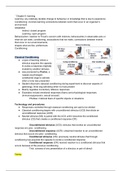Class notes
Chapter6: Learning
- Institution
- Carleton University (CU )
Notes for the sixth chapter of the textbook Weiten, W. & McCann, D. (2019). Psychology: Themes and Variations. Fifth Canadian Edition. Nelson Education Ltd. as well as lecture notes for learning.
[Show more]



